
Are you looking to take the next step towards making your restaurant menu more profitable?
One of the best ways to accomplish this is to dive into the menu engineering matrix for your restaurant.
This concept offers a way for analyzing menu items based on how popular and profitable they are, and gives insights on how to make strategic changes to your menu.
The ultimate goal of this process is to maximize the potential of your menu so that you’re making as much profit for your restaurant as possible.
What Is Menu Engineering?
Menu engineering is the art and science of redesigning a menu to maximize restaurant profits.
It uses a combination of data analysis and menu psychology to help restaurants make informed decisions on how to change their menus.
With menu engineering, you’ll be able to identify and remove poor-performing dishes from your menu so that you can make space for your better-performing ones. You’ll also be able to make decisions on how to best position dishes on your menu so that you can get customers ordering more of your most profitable items.
Understanding the Menu Engineering Matrix
This process is typically shown by using the menu engineering matrix, which categorizes dishes based on their popularity and profitability.
The matrix is a chart that has profitability on the horizontal axis and popularity on the vertical axis.
It enables restaurateurs to place dishes into four categories:
- Stars: Items with high popularity and high profitability.
- Plow Horses: Items with high popularity but low profitability.
- Puzzles: Items with low popularity but high profitability.
- Dogs: Items with low popularity and low profitability.
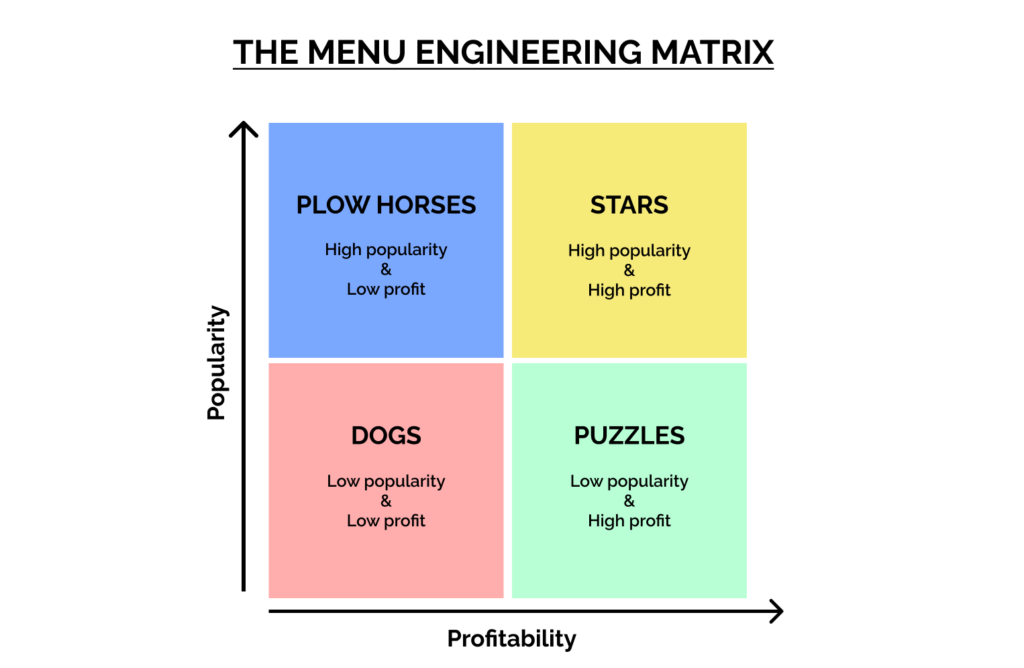
Getting started with the matrix
Collect data on your menu’s performance
The first step of menu engineering is to gather data on the popularity and profitability of each of your menu items.
Menu Item Popularity
Menu item popularity is essentially the amount of sales of each item. This can be found in your point-of-sale system.
Menu Item Profit Margin
Menu item profit margin tells you how much profit your restaurant makes per each menu item sold.
The formula for profit margin is:
Menu item profit margin =
[selling price] – [menu item food cost]
Selling price: Getting the selling price is simple. It’s just the price at which you sell the menu item to customers.
Menu item food cost: As for finding the menu item food cost, there’s a bit more work to do. You’ll have to calculate the exact cost of each ingredient that goes into a recipe.
This is a tedious process, but a good inventory management software solution makes it easier. Here’s an example of the food cost for a linguine with clams recipe. It totals out to a cost of $7.68:
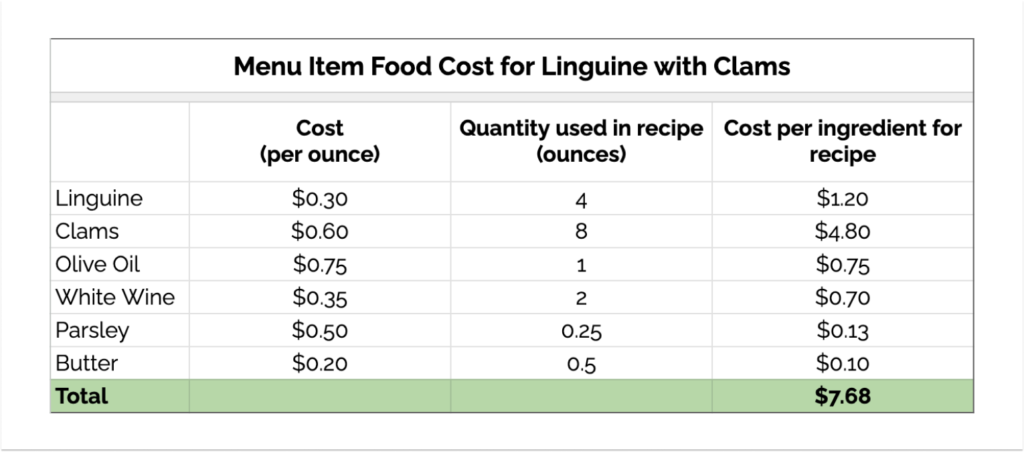
Menu item profit margin: Now let’s calculate the profit margin.
Let’s say the linguine is sold to customers at a price of $16 each.
The profit margin is then:
$16 – $7.68 = $8.32
Categorize items on the menu engineering matrix
Once you know the popularity and profitability of each menu item, you can plot them on the menu engineering matrix to find out which category they fall into.
As an example, let’s visualize the following four dishes on the matrix:
Linguine with clams:
- Sales = 120
- Profit = $8.32
Tagliatelle with lamb ragu:
- Sales = 40
- Profit = $11.14
Chicken Parmesan:
- Sales = 145
- Profit = $4.40
Radicchio salad:
- Sales = 35
- Profit = $3.25
And here’s how they look plotted on the matrix:
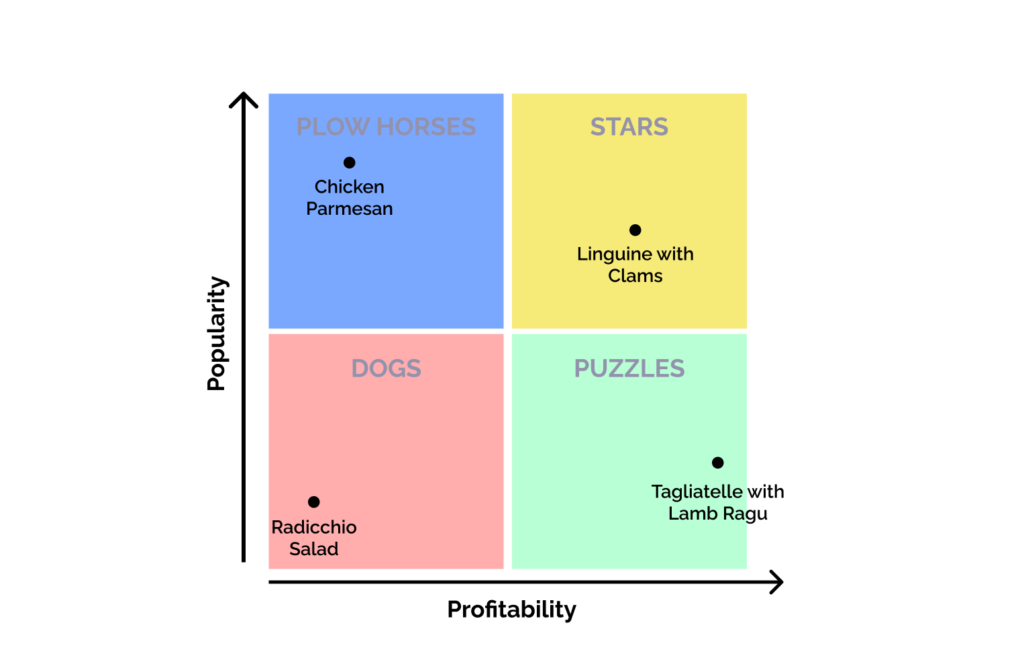
We can see that the Linguine is a star, the Chicken Parmesan is a plow horse, the Tagliatelle is a puzzle, and the Radicchio Salad is a dog.
With this information, you can move on to the next step of taking informed decisions to make changes to your menu.
Stars, Plow Horses, Puzzles and Dogs Explained
Stars: Maximize Their Potential
Stars are literally the stars of your menu. They’re popular with your customers and they have a high net profit.
A restaurant typically wants to maximize the potential of stars by increasing both popularity and profitability.
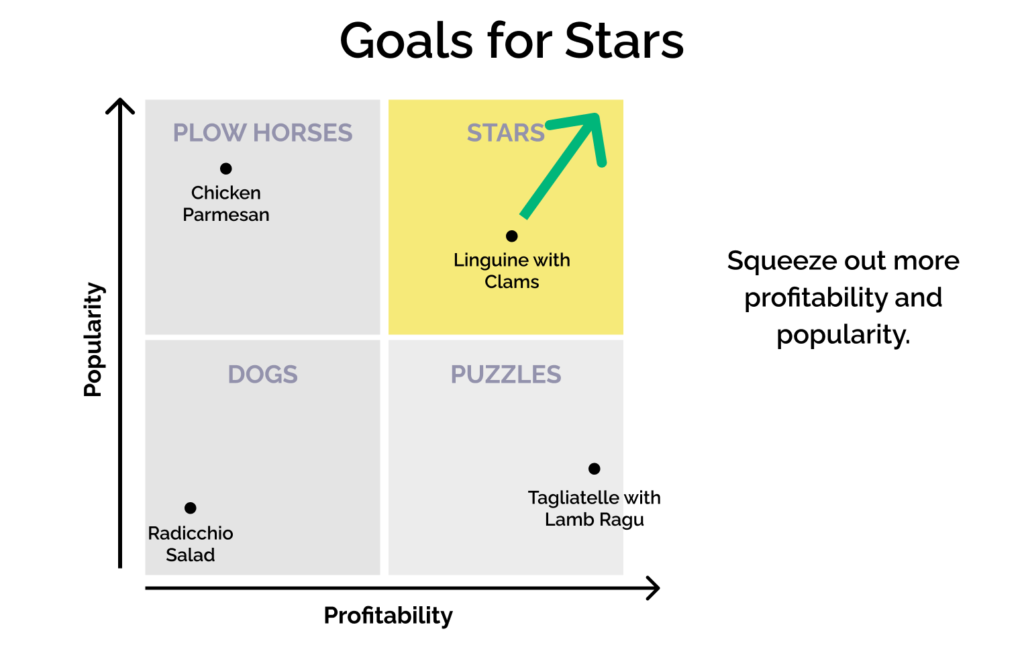
A restaurant could take one or more of the following strategies for stars:
- Ensure consistent quality. These items are popular with your customers, so it’s important to keep their quality high. Don’t make any recipe changes that could negatively impact the quality.
- Ensure consistent availability. It’s also important to make sure that these items are consistently available so that you’re ready to serve them whenever a customer wants to order them.
- Visually highlight stars in menu design. You can move stars to prominent locations on the menu, such as at the top left, or add visual cues to draw customers’ attention to these items. Some strategies for visually highlighting items include adding bold text, call-out boxes, or images. And you can further differentiate the item by adding a longer description or a house special label. The idea is to get more customers viewing these items so that even more customers order them.
- Promotions and advertisements. Since stars are already popular with your customers, they’re great candidates to feature in promotions and advertisements. You know that customers enjoy them, so showcasing these favorites is likely to be an effective way to attract more guests to your restaurant.
- Increase prices. It’s important to not go overboard with this strategy, but a slight price hike could further drive up their profitability. Test a small price increase and see if sales remain consistent.
Plow Horses: Increase Their Profit While Maintaining Popularity
Plow horses are popular with customers, but their profit is lower. The goal for this type of menu item is to figure out a way to increase their profit margin while maintaining their popularity.
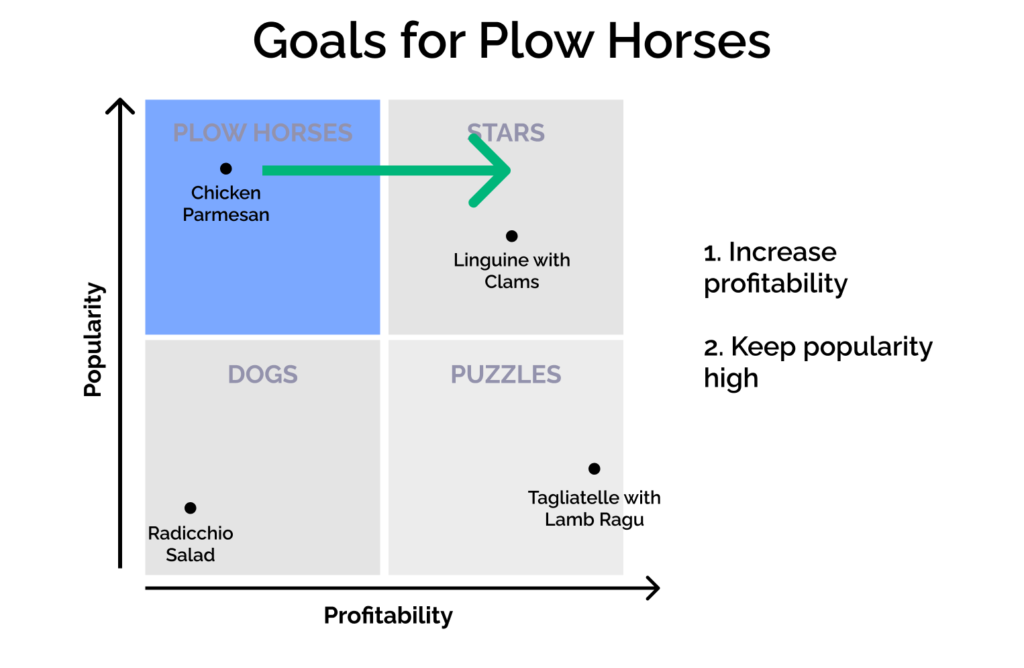
Here are some strategies you can apply to plow horses:
- Increase price. Like stars, plow horses are popular with your customers and may be able to withstand a price increase. You can start with slight increases and assess the sales impact. If customers continue to order plow horses despite the higher prices, you’ve potentially just changed those plow horses into stars.
- Decrease cost. At the same time, consider if it’s possible to reduce the item’s food cost without compromising its quality. Perhaps you can negotiate a better deal on the ingredients from a vendor or substitute one component of the dish with a cheaper alternative.
- Decrease portion size. Evaluate if you can slightly decrease the portion size of plow horses without sacrificing on the overall experience of the dish. A smaller portion size will lead to higher profits.
- Add combination options. Consider offering customers the option to add extras or upgrades to plow horses. For instance, you could offer an option to add a high-margin cornbread side to a BBQ ribs dish. This could increase the net profit for the ribs menu item.
- Make less visible. If all the above fail and you’re not able to increase the profitability of plow horses, consider making them less visible on your menu. You could move them to a less prominent spot on the menu to make space for other, more profitable dishes.
Puzzles: Increase Their Popularity
Puzzles have a high profit margin but are less popular with customers. If more customers would order these dishes, you could make more profit.
The goal for puzzles is to figure out how to increase the sales of these items.
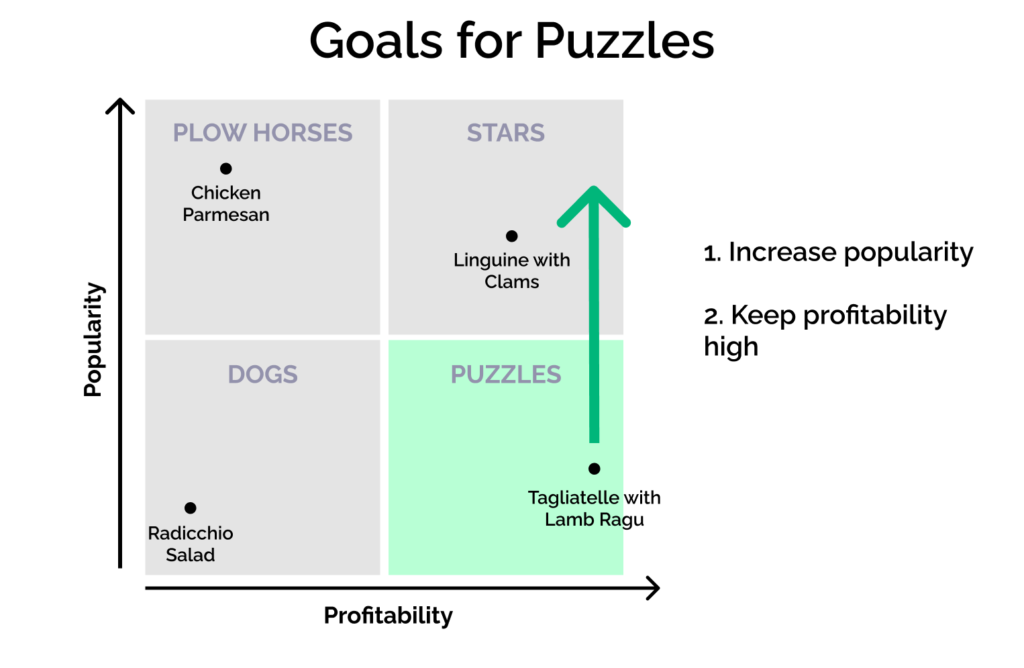
Here are some strategies for handling puzzles:
- Visually highlight puzzles in menu design. Test moving puzzle items to more visually prominent sections of the menu to get more customer eyes on them. You can also try visually highlighting the items with bolded text, call-outs, or images.
- Improve the description. Try expanding their descriptions to make them more detailed and appealing.
- Consider decreasing the price. Perhaps customers have the impression that the price of an item is too high, and that’s why it’s not being ordered. You could try slightly decreasing the price to see if this causes an increase in sales. Just make sure not to reduce the price too much, as you still want these menu items to stay profitable.
- Promote these items. Experiment with promoting these items to your customers. For example, add these items to in-restaurant displays or on table-tents. Feature them more prominently in your marketing channels.
- Change the recipe. Maybe your customers just don’t seem to like the recipe as it’s currently constructed. If this is the case, you could try changing the recipe to make it more appealing to customers. Experiment with different sides or accompaniments. Add new, exciting ingredients or flavors.
Dogs: To Remove or Keep?
Dogs are perfect candidates to consider removal from your menu.
Your customers aren’t ordering them often, and even when they do, they’re not very profitable.
For instance, imagine your menu features two types of burgers, and one of them is a dog. It’s not popular and it’s not profitable. You already have a second burger that does well, so why not consider removing the underperforming one. This could free up space on your menu for other dishes that have more potential.
At the same time, there are certain cases when it makes sense to keep dogs on the menu.
For example, some dogs might appeal to a specific type of person and can therefore make your menu more palatable to groups of customers. Consider a vegan dish on your menu that isn’t very popular. Although it doesn’t sell very well, it caters to a group of customers that might include a vegan, offering something for everyone. Without the vegan dish, this group might choose a different restaurant that accommodates everyone’s needs.